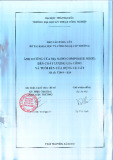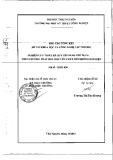
REVIEW ARTICLE
Chemical approaches to mapping the function
of post-translational modifications
David P. Gamblin, Sander I. van Kasteren, Justin M. Chalker and Benjamin G. Davis
Chemistry Research Laboratory, Department of Chemistry, University of Oxford, UK
Introduction
Post-translational modifications (PTMs) of proteins
modulate protein activity and greatly expand the diver-
sity and complexity of their biological function. The
ubiquity of PTMs is reflected in their widespread roles
in signaling, protein folding, localization, enzyme acti-
vation, and protein stability [1–3]. Indeed, the preva-
lence of such modifications in higher organisms, such
as humans, is a leading candidate for the origin of
such complex biological functions [4], which may arise
from a comparatively restricted genetic code [5–7]. As
a consequence of the lack of direct genetic control of
their biosynthesis, natural PTMs vary in site and level
of incorporation, leading to mixtures of modified pro-
teins that may differ in function. In order to fully dis-
sect the biological role of PTMs and determine precise
structure–activity relationships, access to pure protein
derivatives is essential. One approach is to exploit the
fine control that may be offered by chemistry [4]. A
combination of chemical, enzymatic and biological
augmentation strategies can provide a modification
process that occurs with the chemoselectivity and regio-
selectivity that is often lacking in the natural produc-
tion of post-translationally modified proteins [8]. This
allows the construction not only of post-translationally
Keywords
chemoselective ligation; post-translational
modification; protein glycosylation; protein
modification; synthetic proteins
Correspondence
B. G. Davis, Chemistry Research
Laboratory, 12 Mansfield Road,
Oxford OX1 3TA, UK
Fax: 44 (0) 1865 285 002
Tel: 44 (0) 1865 275652
E-mail: ben.davis@chem.ox.ac.uk
Website: http://www.chem.ox.ac.uk/
researchguide/bgdavis.html
Note
Taken in part from Young Investigator
Award lecture delivered to the MPSA 2006
meeting in Lille
(Received 18 July 2007, revised 10 February
2008, accepted 21 February 2008)
doi:10.1111/j.1742-4658.2008.06347.x
Strategies for the chemical construction of synthetic proteins with precisely
positioned post-translational modifications or their mimics offer a powerful
method for dissecting the complexity of functional protein alteration and
the associated complexity of proteomes.
Abbreviations
EPL, expressed protein ligation; glycoMTS, glycosyl methanethiosulfonates; glycoSeS, selenenylsulfide-mediated glycosylation;
MTS, methanethiosulfonates; NCL, native chemical ligation; PTM, post-translational modification; SBL, subtilisin Bacillus lentus.
FEBS Journal 275 (2008) 1949–1959 ª2008 The Authors Journal compilation ª2008 FEBS 1949

modified proteins but also of their mimics [4,9,10]. The
chemical motif introduced should thus be sufficiently
similar to the natural modification to mimic its func-
tion; varying this chemical appendage presents the
opportunity for imparting different or enhanced bio-
logical activity.
Among PTMs, protein glycosylation is the most pre-
valent and diverse [11,12]. The glycans on proteins
play key roles in expression and folding [13], thermal
and proteolytic stability [14], and cellular differentia-
tion [15]. Carbohydrate-bearing proteins also serve as
cell surface markers in communication events such as
microbial invasion [16], inflammation [17], and
immune response [11,12]. The study of these events is
taxing, as the biosynthesis of glycoproteins is not tem-
plate driven. This results in the formation of so-called
‘glycoforms’ [11,12], proteins with the same peptide
backbone that differ in the nature and site of glycan
incorporation. Ready access to homogeneous glyco-
forms is hampered by inadequate separation technol-
ogy that has afforded homogeneous glycoproteins only
in rare instances [18]. The limited availability of singu-
lar glycoforms has prompted a concerted effort to
develop new methods for their synthesis [8].
Biological methods to obtain glyco-
proteins
The natural expression of glycoproteins is highly
dependent on the host cell glycosylation machinery.
However, the re-engineering of the glycosylation path-
way in the yeast Pichia pastoris has resulted in near-
homogeneous expression [19–23], although, at present,
this method lacks flexibility and non-natural variants
are not tolerated. The examples of pure glycans dis-
played on recombinant proteins are therefore limited,
thus far, to only a few structures such as the bianten-
nary structure GlcNAc
2
Man
5
GlcNAc
2
[20] and its
extended variants Gal
2
GlcNAc
2
Man
3
GlcNAc
2
[19] and
Sia
2
Gal
2
GlcNAc
2
Man
3
GlcNAc
3
[21].
An alternative approach exploits ‘misacylated’
tRNAs in codon suppression read-through techniques
to produce homogeneous glycoproteins [24]. In vivo
evolution of a tRNA synthetase–tRNA pair from
Methanococcus jannaschii capable of accepting and
loading glycosylated amino acids has allowed the
introduction of O-b-d-GlcNAc-l-Ser [25] and
O-a-d-GalNAc-l-Thr [26] into proteins with efficien-
cies of 96% and 40% respectively.
In addition to expression-based approaches, biocata-
lytic methods can allow the so-called remodeling of
modifications such as glycosylation. Endoglycosidases
and glycosyltransferases have been used to modify
existing glycoforms, e.g. in the creation of a single
unnatural glycoform of enzyme RNaseB [27] catalyzed
by the glycoprotein endoglycosidase enzyme endo A
using novel synthetic oxazoline oligosaccharide
reagents [28,29].
The above solely biological methods offer great
potential. However, despite the impressive results listed
above, these strategies may be limited by the often
stringent specificity of natural catalytic machinery in a
way that can limit their versatility and general applica-
tion to modified protein (glycoprotein) synthesis.
Chemical strategies in glycoprotein
synthesis
The chemical attachment of glycans offers an alterna-
tive, pragmatic route to homogeneous glycoproteins.
Chemical methods can be divided into two complemen-
tary strategies [4] (Fig. 1): linear assembly, such as the
introduction of a well-defined modified peptide (glyco-
peptide) into a larger peptide backbone; and convergent
assembly, such as chemoselective ligation of a modifica-
tion (glycoside) to a side chain in an intact protein scaf-
fold. These terms reflect not only the linearity or
convergence of the chemical steps that may lead to a
given synthetic protein, but also the structural strategy
that links the (linear) segments of the protein backbone
or (convergently) attachs components ⁄modifications to
this backbone (typically to residue side chains) with
little or no alteration of the backbone itself.
In linear assembly, small modified peptides (glyco-
peptides and glycoamino acids) can be ligated to other
peptide fragments. Linear assembly methods include
the use of native chemical ligation (NCL) [30], which
has been applied to form, for example, unmodified
protein barnase [31] and a poly(ethylene glycol)-modi-
fied variant of erythropoeitin (EPO) [32]. More
recently, the use of expressed protein ligation (EPL)
has provided access to larger peptide fragments. Mac-
millan et al. have used EPL to construct three well-
defined model GlyCAM-1 glycoproteins [33], the first
reported modular total synthesis of a biologically rele-
vant glycoprotein. The immediate compatibility of
NCL and EPL methods has led to their widespread
adoption. Other methods, however, also provide
emerging alternatives, such as traceless Staudinger pep-
tide [34] ligation and protease-mediated peptide liga-
tion [35,36].
Not withstanding these clear demonstrations of the
utility of linear ligation assembly, a convergent chemo-
selective approach can offer the key advantages of
more ready and flexible modification of a well-defined
protein structure. While also developing novel methods
Exploring post-translational modification D. P. Gamblin et al.
1950 FEBS Journal 275 (2008) 1949–1959 ª2008 The Authors Journal compilation ª2008 FEBS

for linear assembly [36], it is this convergent strategy
that we have typically adopted in our own efforts in
the synthesis and study of precisely modified proteins.
The central strategic concept behind this convergent
chemical protein modification (glycosylation) is one of
‘tag and modify’ (Fig. 2): the introduction of a tag into
the protein backbone followed by chemoselective mod-
ification of that tag. This allows for greater flexibility
in choice of protein, carbohydrate and modification
(glycosylation) site.
With the relatively low abundance and unique reac-
tivity profile of cysteine, S-linked chemical modifica-
tions are attractive targets for selective, well-defined
PTM mimicry. In protein glycosylation, surface-
exposed cysteine residues can be alkylated [37–39] or
converted to the corresponding disulfide [40]. Further-
more, when it is used in combination with site-directed
mutagenesis [41,42], glycans of choice can be intro-
duced at any predetermined site. First-generation
disulfide-forming reagents such as glycosyl methane-
thiosulfonates (glycoMTS) or phenylthiosulfonates
provided reliable access to homogeneous glycoproteins
with high efficiency [41,43]. These allowed the first
examples of the systematic modulation of enzyme
activity [amidase and esterase activity of the serine
protease subtilisin Bacillus lentus (SBL)] and demon-
strated not only precise glycosylation but also the
dependence of activity on the exact site and identity of
the disulfide-linked glycan [44].
Interestingly, judicious site selection for incorpora-
tion of a desired PTM revealed the dramatic effects of
‘polar patch’ modifications [45,46]. Precisely intro-
duced charged modifications converted the protease
SBL into an improved biocatalyst in peptide ligation.
Particularly striking was the broad substrate tolerance
that could be engineered (e.g. towards non-natural
amino acids) by appropriate incorporation of the polar
domain [47]. In an example that combines the explora-
tion of two modes of modification, ‘polar patch’-modi-
fied enzymes have also been applied to the catalysis of
glycan-modified glycopeptide ligation [36].
Our early success using glycoMTS-mediated protein
glycosylation along with a rich history of modifications
using MTS reagents [48] highlighted the method as a
general tool in protein modification, and we have since
used this chemistry in a variety of site-selective ‘tag
and modify’ reactions, reliably incorporating desired
functionality or PTM. For instance, a library of ‘cata-
lytic antagonists’ was engineered for affinity proteolysis
by incorporation of a variety of ligands onto protease
SBL, including examples of natural PTMs such as
biotinylation and d-mannosylation (Fig. 3) [49]. The
pendant ligands allowed SBL to selectively bind a
protein target or partner and, by virtue of proximity,
Fig. 1. Two complementary chemical strat-
egies for mimicking PTM. Taken from [4].
D. P. Gamblin et al. Exploring post-translational modification
FEBS Journal 275 (2008) 1949–1959 ª2008 The Authors Journal compilation ª2008 FEBS 1951

catalyze enhanced hydrolytic degradation of the target
protein.
More recently, the glycoMTS method has allowed
the synthesis of the first examples of a homogeneous
protein bearing symmetrically branched multivalent
glycans [50,51]. This new class of glycoconjugate, the
‘glycodendriprotein’, exists in two-arm, three-arm or
four-arm variants tipped with sugars. These are
designed to mimic the branching levels in complex
N-glycans, which come in bi-antennary, tri-antennary
and tetra-antennary form. For example, the synthe-
sized divalent, trivalent and tetravalent d-galacto-
syl-tipped glycodendriproteins effectively mimicked
glycoproteins with branched sugar displays, as indi-
cated by a high level of competitive inhibition of the
coaggregation between the pathogen Actinomyces naes-
lundii and its copathogen Streptococcus oralis. This
inhibition, when coupled with targeted pathogen
degradation, offers therapeutic potential for the treat-
ment of opportunistic pathogens [50,51].
This ‘tag and modify’ two-step approach has proved
a widely successful strategy for site-selective glycosyla-
tion, used by several groups. For example, Flitsch
et al. have employed glycosyliodoacetimides to site-
selectively modify erythropoietin [52]. A similar
strategy has been reported by Withers et al. where
glycosyliodoacetimides were used in conjunction with
site-selective modification of the protein endoxylanase
from Bacillus circulans (Bcx) [53]. A protected thiol-
containing sugar was conjugated and then chemically
exposed before enzymatic extension. Boons et al. have
used aerial oxidation and disulfide exchange to form
homogeneous disulfide-linked glycoproteins via a
cysteine mutation in the Fc region of IgG
1
[42,54].
More recently, second-generation thiol-selective pro-
tein glycosylation reagents that rely upon selenenyl-
Fig. 2. The ‘tag and modify’ strategy behind convergent modification, illustrated here for dual tag and dual modify. Taken from [10].
Exploring post-translational modification D. P. Gamblin et al.
1952 FEBS Journal 275 (2008) 1949–1959 ª2008 The Authors Journal compilation ª2008 FEBS

sulfide-mediated glycosylation (glycoSeS) have greatly
improved the efficiency of ‘tag and modify’ methods
[55]. In this approach, cysteine-containing proteins and
glycosyl thiols combine through phenyl selenenylsulfide
intermediates (Fig. 4). Preactivation of either the cyste-
ine mutant protein or thiosugar is possible following
exposure to PhSeBr.
GlycoSeS was initially demonstrated on simple
cysteine-containing peptides, and then shown to be
successful on a variety of different proteins, highlight-
ing its versatility for glycosylation in a variety of pro-
tein environments. This high-yielding procedure also
provided the first example of multisite-selective glyco-
sylation with the same glycan and the coupling of a
AB
Fig. 3. (A) The use of a thiol ‘tag and modify’ strategy allowed site-selective attachment of natural PTMs such as biotin (1) and D-mannose
(2) that, in turn, acted as ‘homing’ ligands for affinity proteolysis of target PTM-binding proteins. (B) A ring of modification sites (blue) around
the active site (red) of the modified protease was explored. Taken from [49].
Fig. 4. Two complementary routes in glyco-SeS: protein activation and glycosyl thiol activation. The disulfide-linked glycoproteins were
then readily processed in on-protein transformations catalyzed by glycosyltransferases, leading to, for example, a sialyl Lewis
X
-tetrasaccha-
ride glycan.
D. P. Gamblin et al. Exploring post-translational modification
FEBS Journal 275 (2008) 1949–1959 ª2008 The Authors Journal compilation ª2008 FEBS 1953


























